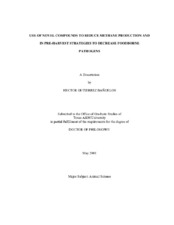| dc.description.abstract | The first aim of this study (Chapter III), the effects of chlorate and nitroethane on
foodborne pathogens and rumen fermentation were evaluated. The experimental chlorate
product, reduced (P < 0.001) fecal, but not ruminal (P > 0.05) E. coli concentrations by
1000- and 10-fold by 24 and 48 h after chlorate feeding when compared to pre-treatment
concentrations (> 5.7 log10 colony forming units/g). Nitroethane treatment decreased (P
< 0.01) ruminal (8.46, 7.91 and 4.74 ± 0.78 μmol/mL h-1) and fecal (3.90, 1.36 and 1.38
± 0.50 μmol/g h-1) methane-producing activity for treatments 0, 80 and 160 mg
nitroethane/kg body weight per day, respectively. Whole animal methane emissions,
expressed as L/d or as a proportion of gross energy intake (%GEI) were unaffected by
nitroethane treatment (P > 0.05).
The second aim of this study (Chapter IV) was conducted to examine the effects
of nitroethane and monensin on ruminal fermentation and nitro-metabolizing bacterial
populations in vitro. The addition of nitroethane decreased methane production
(μmol/mL) by at least 90%. The most probable number (MPN) of nitro-metabolizing bacterial populations was increased (P < 0.01) with the addition of nitroethane by at least
3 log10 cells/mL compared with monensin, monensin plus nitroethane or the control
group.
The final aim of this study (Chapter V) evaluated the effect of two sources of
tannins, chestnut (CT) and mimosa (MT) on foodborne pathogens when applied as a
hide-intervention and as a feed additive to feedlot cattle. Tannin spray application
showed no effect of treatment or application-time (P > 0.05) on E. coli/total coliforms
and total aerobes. Chestnut tannin decreased bacterial load of ruminal E. coli and total
coliform by at least 0.4 log10 CFU/mL. However, fecal E. coli concentrations were
increased with mimosa by 0.3 log10 CFU/g. Also, fecal total coliforms increased with the
addition of chestnut or mimosa by at least 0.3 log10 CFU/g. Fecal Campylobacter
concentrations (log10 CFU/g) increased with the addition of chestnut and mimosa by at
least 0.4 log10 CFU/g. | en |


